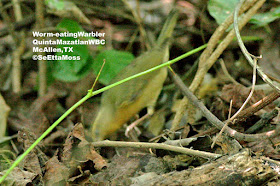I have extracted salient portions of the annual crane season at Aransas NWR in Texas:
"The tenth aerial census of the 2008-09 crane season at Aransas was
conducted April 7, 2009 with USFWS observer Tom Stehn in a Cessna 210
piloted by Gary Ritchey of Air Transit Solutions of Castroville,
Texas. . . .
Today's flight tallied 103 adults + 6 juveniles = 109 total. Thus, 56% of
the flock has started the migration. Whooping cranes have been confirmed
on April 2nd as far north as Nebraska. I expect a considerable number of
cranes will start the migration in the next week. Conditions should be
ideal for departure with very strong southeast winds forecast for Aransas
April 8-9. . .
Mortality
Today's flight provided evidence of 2 additional mortalities, with total
winter mortality now estimated for the winter at 7 adults and 16 chicks
totaling 23 whooping cranes, a loss of 8.5% of the flock that was a record
270 in the fall. In the last 20 years, the current winter ranks as the
worst in terms of mortality, ahead of 1990 when 7.5% of the whooping cranes
(11 out of 146) died at Aransas. The 3rd worst winter in 1993 showed a
4.9% loss at Aransas (7 out of 143). Mortality in the 2008-09 winter (23
birds) can be added to the 34 whooping cranes that left Aransas in the
spring of 2008 and failed to return in the fall. Thus, 57 whooping cranes
have died in the last 12 months, or 21.4% of the flock of 266 present at
Aransas in the spring, 2008.
The 2 additional mortalities confirmed on today's flight that had been
reported earlier by volunteers and staff . . . .
Overall, these continue to be some of the worst conditions I have ever
observed for the cranes at Aransas, with some birds looking thin and with
disheveled plumage. The refuge is continuing its program of supplemental
feeding with corn. A moderate response by the whooping cranes has
continued. The cranes are getting somewhat of an energy boost by catching
fiddler crabs just prior to migration.
By Tom Stehn - Aransas National Wildlife Refuge"
Read the
full report and find additional crane information too. SeEtta
 This female Painted Bunting was foraging in the same location as the male pictured in the post below. Though her plumage is not as brilliant as that of the male, she was still quite colorful with her bright greenish feathers. She was less reticent than the male so I got to watch her for several minutes and got several pics.
This female Painted Bunting was foraging in the same location as the male pictured in the post below. Though her plumage is not as brilliant as that of the male, she was still quite colorful with her bright greenish feathers. She was less reticent than the male so I got to watch her for several minutes and got several pics. A few blue feathers on the shoulder area and a few around the head area show up in several pics. Birds of North America online states that females in Basic I plumage may have blue feathers on their heads.
A few blue feathers on the shoulder area and a few around the head area show up in several pics. Birds of North America online states that females in Basic I plumage may have blue feathers on their heads. This female and the male Painted Bunting, in addition to foraging close together, interacted at one point. This makes me wonder if they are paired-up. SeEtta
This female and the male Painted Bunting, in addition to foraging close together, interacted at one point. This makes me wonder if they are paired-up. SeEtta
































